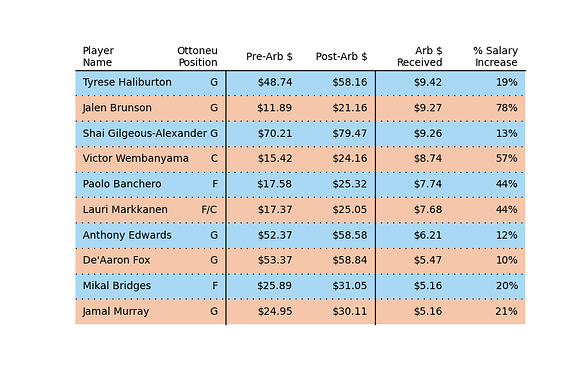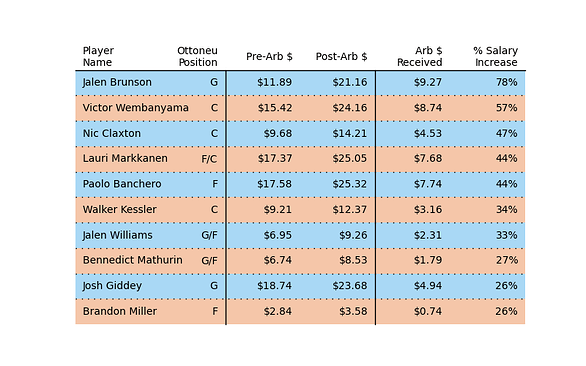I pulled the average salaries for Ottobasket on the final day of arbitration and the day after when it was applied throughout the system in an attempt to find some insights into how arbitration was applied this offseason. I pulled the data right before arbitration was applied in the hopes that it would minimize the cuts any managers made and their impact on the dataset. Once I had the data, I simply calculated the absolute and percentage differences between the new and old average salaries.
Here are tables and text for the top 10 results of each. Feel free to just look at the tables and skim the text if you want!
The top raw $ increase players are headlined by three breakout guards who all broke the $9 mark and were all in the top 6 in voting for the NBA’s Most Improved Player award. Tyrese Haliburton got a whopping $9.42 in arbitration after putting up an insanely good season, particularly for categories and traditional points scoring, with nearly 21 PPG along with 10.4 APG and only 2.5 turnovers each night. He also did this with a shooting slash line of 49/40/87.1 and finished 6th in the Most Improved Player voting. His post-arbitration average salary is at $58.16.
Jalen Brunson stands out to me in this group as the player most likely to show up on the list again next year since he’s still at a great average price of $21.16. He was more scoring oriented than Haliburton with 24 PPG and only 6.2 APG, but he likewise rarely turned the ball over for a high usage player and shot the ball efficiently.
Shai Gilgeous-Alexander, the runner up for Most Improved Player, is the highest salary player in the table and now averages nearly $80 across Ottobasket leagues. He crested the 30 PPG mark, getting up to 31.4 PPG as his crafty game lead the Thunder to a surprising playoff push. He benefited from not having to handle all of the creation responsibility for OKC with Josh Giddey and Jalen Williams helping out in that department. An underrated part of his value this past year was playing in 68 games, his highest total since his first year in OKC and aided by that playoff push, which kept the Thunder from shutting him down late in the year.
Up next are two young players as the Wemby hype train is full steam ahead in the Ottoverse as well as real life and Paolo Banchero took home the Rookie of the Year award. If they can keep growing and adjusting, then they could still be good deals next season. Banchero put up 20 PPG, nearly 7 RPG, and 3.7 APG as a rookie with decent two point and free throw percentages. He went through a brutal stretch from behind the arc later in the year that pulled his three point and overall field goal percentages down, making him a liability at this value in categories leagues but well worth it in points leagues. If he can up those percentages as a second year player, he could be valuable regardless of format.
Wembanyama is up over $24 after receiving a quarter shy of $9 in arbitration on average and I think everyone is excited to see what he can do in San Antonio this season. He was pretty amazing in France last year and if the Spurs get him to cut out some of the worst three point attempts, he could be great across all formats from the jump.
Lauri Markkanen was perhaps the breakout star in the league and wrapped it up by winning Most Improved Player for the Jazz. He had long teased his potential, particularly in his second season and basically anytime he played with the Finnish national team, but between moving down the Bulls’ pecking order and then playing slightly out of position for Cleveland, he wasn’t living up to it. He sure did last year, jumping up to 25.6 points and 8.6 rebounds while only missing a 50/40/90 season by 3.5 combined percentage points and was rewarded in arbitration by receiving $7.68 and bumping his average salary up to $25.05.
Anthony Edwards, De’Aaron Fox, and Mikal Bridges all broke out in one way or another this season and for various reasons. Edwards upped his numbers across the board as he took on more usage and responsibility once Karl-Anthony Towns went down with an injury and Edwards got used to playing with Gobert. I suspect he’ll continue to be very good this year, but the return of KAT does introduce some doubt about how valuable he’ll be in fantasy. He got bumped over $6 in arbitration and now sits at $58.58 on average.
Fox helped break Sacramento’s nearly 20 season playoff drought with his leap in his first full season teaming up with Domantas Sabonis. He increased his two point and free throw percentages while dropping his turnovers to nearly a career low and getting his points and assists per game back up closer to his 2020-21 numbers. He received about $5.50 in arbitration and his average salary is just above Edwards’ at $58.84.
Bridges took the mini-leap he was taking in Phoenix and put it into overdrive once he moved to Brooklyn. He upped his scoring all the way to 26.1 PPG while maintaining his elite percentages and solid defensive numbers, though the 3.6 APG he was averaging in Phoenix dropped down to 2.7 in Brooklyn. His average salary now sits just over $31 after getting $5.16 on average in arbitration.
Jamal Murray wraps up the top 10 as he also received $5.16 on average to get pushed right over the $30 mark. He convincingly returned from his ACL tear to lead the Nuggets win their first NBA title along with Nikola Jokic. His and the Nuggets’ playoff performance may have influenced his arbitration numbers due to the halo effect and recency bias as his regular season numbers were below Brunson’s in most instances. He’s now a few dollars shy of par value in simple and traditional points leagues and a few above it for categories leagues according to my valuations for the past season.
This table is for the players whose salary increased the most as a percentage of their former salary. As you might guess, rookies and soon-to-be rookies make up most of the table with six entries and Wembanyama, Brunson, Markkanen, Banchero, and Claxton make repeat appearances. The only player who fits neither description is Josh Giddey, who built on his 2021-22 rookie season with a highly impressive second year that was effective in all formats.
Brunson easily lead the way and his salary increase was a whopping 78% while Wembanyama comes in at 57%. Managers are clearly expecting big things out of him from the start and want to remove any surplus value he might have as soon as possible. Claxton went up nearly 50% to just over $14 and Markkanen and Banchero both increased 44% to around $25.
Frankly I was surprised to not see Walker Kessler higher on this list with his incredible rookie season, though his $9.21 pre-arb average salary is higher than expected and means he finished the season at $6.21 before the $3 increase. I suspect he was dropped by a decent amount of managers around auction time or early in the season and then was re-auctioned once he started to establish himself. He should provide a ton of surplus again this year in categories and traditional points leagues.
Jalen Williams and Ben Mathurin are the two other rookies showing up in the table as they received $2.31 and $1.79 in arbitration, respectively. Along with Banchero and Kessler, they make up the top 4 in Rookie of the Year voting from this year. Williams showed a strong all-around game to contribute in each format and really finished the season strong to get that second place finish. Mathurin was more focused on points, but also contributed in the free throws made category.
Lastly we have Brandon Miller, and you can see his relatively unheralded preseason status reflected in his season closing price of $1.84. I think there’s a good chance he doesn’t contribute much outside of the simple points format this year between not being as high on him in general, his less than steller Summer League showings, and the Hornets’ wing situation. They brought back Miles Bridges, still have Gordon Hayward, and could still bring back PJ Washington, leaving less minutes for Miller than most top picks.
Overall you can see how managers are tagging young players with arbitration money once they show they can contribute to an NBA team. Playing the prospect game in Ottobasket is different than Ottoneu baseball (I haven’t played Ottofootball) as there’s a set time players will debut and once success is had and surplus value established, there’s a need to offset it as much as possible. Any manager sitting on Banchero, Kessler, and Williams is well set up for the future regardless of scoring format and can spend big on stars come auction season. Of course, anyone who also held Chet Holmgren and Jabari Smith is still waiting on those contributions.
If I have time, I’m going to try and add another layer to this analysis by bringing in surplus value for each player and scoring format. The arbitration numbers aren’t split out by format, but it could still give us a sense for who was targeted and who maybe should have been targeted but was not.

